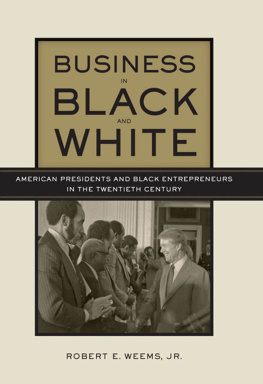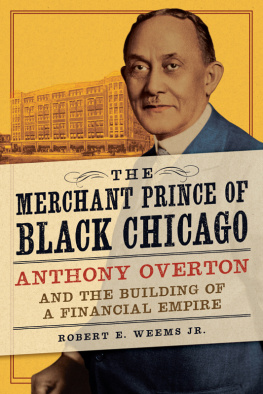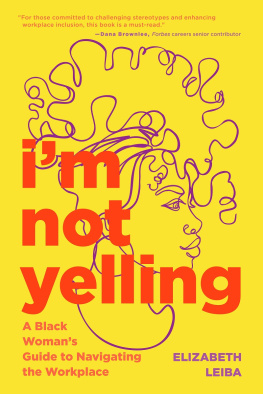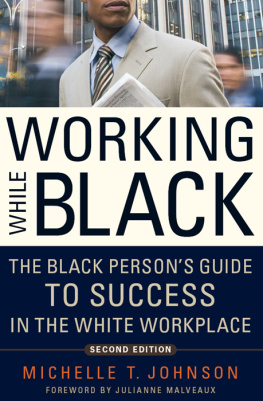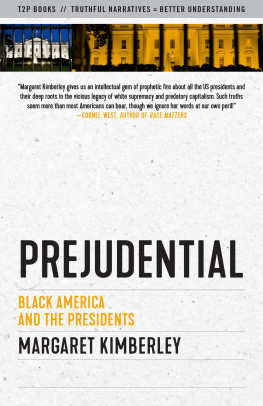Thank you for buying this ebook, published by NYU Press.
Sign up for our e-newsletters to receive information about forthcoming books, special discounts, and more!
Sign Up!
About NYU Press
A publisher of original scholarship since its founding in 1916, New York University Press Produces more than 100 new books each year, with a backlist of 3,000 titles in print. Working across the humanities and social sciences, NYU Press has award-winning lists in sociology, law, cultural and American studies, religion, American history, anthropology, politics, criminology, media and communication, literary studies, and psychology.
Business in Black and White
Business in
Black
and White
American Presidents &
Black Entrepreneurs in
the Twentieth Century
Robert E. Weems Jr.,
with Lewis A. Randolph
NEW YORK UNIVERSITY PRESS
New York and London
www.nyupress.org
2009 by New York University
All rights reserved
Library of Congress Cataloging-in-Publication Data
Weems, Robert E., 1951
Business in black and white : American presidents and Black entrepreneurs
in the twentieth century / Robert E. Weems, Jr. ; with Lewis A. Randolph.
p. cm.
Includes bibliographical references and index.
ISBN-13: 978-0-8147-7517-2 (cloth : alk. paper)
ISBN-10: 0-8147-7517-9 (cloth : alk. paper)
1. African American businesspeopleUnited StatesHistory20th century.
2. EntrepreneurshipUnited StatesHistory20th century. 3. CapitalismUnited
StatesHistory20th century. 4. African AmericansEconomic conditions20th
century. 5. PresidentsUnited StatesRacial attitudesHistory20th century.
6. United StatesRace relationsPolitical aspectsHistory20th century. 7. United
StatesPolitics and government19191933. 8. United StatesPolitics and govern
ment19331945. 9. United StatesPolitics and government19451989. 10. United
States. Dept. of CommerceHistory20th century. I. Randolph, Lewis A. II. Title.
HD2358.5.U6W44 2009
338.0408996073dc22 2008037023
New York University Press books are printed on acid-free paper,
and their binding materials are chosen for strength and durability.
Manufactured in the United States of America
10 9 8 7 6 5 4 3 2 1
Contents
1 The Origins of the Commerce Departments
Division of Negro Affairs, 19251940
2 Emmer Lancaster and the Ascendancy and Fall of the
Commerce Departments Division of Negro Affairs,
19401960
3 More Than Civil Rights: The Kennedy and Johnson
Administrations and African American Enterprise
4 The Democratic Party and Black Capitalism during
the Presidential Election of 1968
5 Nixon and the Militants: The GOP and Black
Capitalism during the Presidential Election of 1968
6 The National Response to Richard M. Nixons
Black Capitalism Initiative
8 The Carter Administration and
African American Enterprise
List of Tables
Table 3-1 Participant Cities: The 6-by-6 Loan and Management
Program as of June 23, 1965
Table 3-2 Selected Characteristics of Economic Opportunity
Loan Program, November 1966 to February 1967
Table 4-1 Brief Description of Robert F. Kennedys Suggested
Use of Specific Community Development Tools in
Rebuilding Black Urban Areas
Table 4-2 Brief Description of Richard Nixons Suggested
Use of Specific Community Development Tools
in Rebuilding Black Urban Areas
Table 8-1 Comparison of Total Government Procurement with
Minority Procurement, Fiscal Years, 1969 to 1980
Acknowledgments
First I want to acknowledge the contribution of political scientist Lewis A. Randolph to the current study. His discussion of Richard Nixons and Robert Kennedys 1968 presidential campaigns, as well as his input regarding Vice President Richard Nixons chairmanship of the Presidents Committee on Government Contracts (PCGC), enhanced this project.
Doing archival-based research requires the help of numerous archivists and librarians. I am personally indebted to the staffs of the following institutions: the National Archives (College Park, MD), the Herbert Hoover Presidential Library and Birthplace (West Plains, IA), the Harry Truman Presidential Library (Independence, MO), the John F. Kennedy Presidential Library (Boston), the Lyndon B. Johnson Presidential Library (Austin, TX), the Richard Nixon Library and Birthplace (Yorba Linda, CA), the Gerald Ford Presidential Library (Ann Arbor, MI), the Jimmy Carter Presidential Library (Atlanta) the Ronald Reagan Presidential Library (Simi Valley, CA), the Chicago Historical Society (Chicago), the Presbyterian Historical Society (Philadelphia), the University of North Carolina Archives (Chapel Hill), and the Rockefeller Family Archives (Sleepy Hollow, NY). I also want to offer a special thanks to the Gerald Ford Presidential Library for giving me a research travel grant to work there.
To write the chapters on the Division of Negro Affairs in the Commerce Department, I used the resources of the National Personnel Records Center (NPRC) in St. Louis, MO, which holds the personnel records of former civilian government employees. I want to thank the NPRC for its assistance, as well as Jerry L. Wallace, historian and archivist at Southwestern College in Winfield, KS, who told me about this important source of information.
I also want to acknowledge the financial support I received from the University of Missouri Research Board and the Research Council of the University of Missouri at Columbia. This assistance helped defray the expenses associated with doing research at several presidential libraries and the National Archives.
Besides receiving the assistance of archivists, librarians, and various funding sources, this project benefited from consultations with a variety of colleagues. Four persons who stand out in this regard are Jonathan J. Bean, Juliet E. K. Walker, Randall Ripley, and Brian Pollins. Bean, a historian of U.S. government initiatives aimed at small businesses, brought to my attention numerous sources that aided this research. I truly appreciate his collegial generosity. Walker, the director of the Center for Black Business History, Entrepreneurship, and Technology at the University of Texas at Austin, shared her encyclopedic knowledge of African American business history, which helped me better conceptualize this book. Ripley and Pollins helped Lewis A. Randolph formulate the concept of domestic dtente to explain Richard M. Nixons interest in promoting African American business development, or black capitalism.
Because Richard Nixon is the president most closely associated with government programs aimed at helping black business enterprise, Lewis Randolph and I tried to contact persons who worked closely with him in order to investigate Nixons reasons for promoting black capitalism. Three former Nixon aidesMartin Anderson, an economic adviser to the 1968 Nixon presidential campaign; Robert Brown, special assistant to President Nixon; and John W. Dean, the former White House counselgraciously answered our questions about both the candidate and the president Nixon.
A special word of thanks goes to Debbie Gershenowitz at New York University Press. I truly appreciate her support of this project. In addition, I want to thank Niko Pfund, the former editor in chief and director of New York University Press, for his support.

